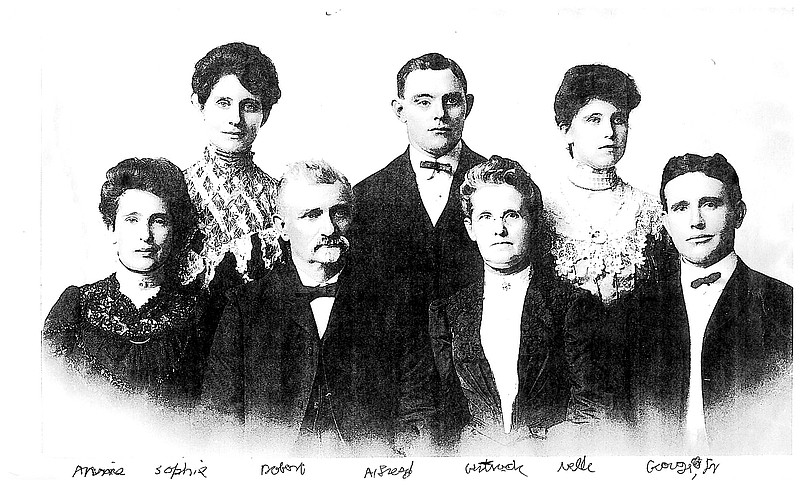A family friend joked that Robert Scholze came to Chattanooga in 1870 to make his fortune with an iron pot and a dead mule. Born Wilhelm Robert Scholze in Zittau, Germany, in 1843, he came in search of a tannery site.
His father, Ernest Wilhelm Scholze, and his wife, Christiana J. Boahme, had immigrated to and established a tannery in Pittsburg, Pa., in 1865.
Robert returned from Chattanooga to Pittsburgh in 1870 to marry Anna Gertrude King, also from Germany. Members of both families moved that year to Blowing Springs, Ga., where they opened a dairy.
Shortly thereafter, Scholze started a tannery on Chattanooga Creek at the foot of Lookout Mountain near where Daniel Ross, father of Principal Chief John Ross, had operated a store and stand for travelers before the Cherokee Removal in 1838.
In 1878, Scholze established Southern Saddlery to manufacture harnesses, saddles, bridles and collars. In addition to the tannery, saddlery and a collar factory, the Scholze complex grew to include a shed for the chestnut oak bark that teamsters brought down the "W" Road from Signal Mountain.
Robert Scholze and his brothers, Ernst and Julius, soon ran other businesses nearby, including a soap factory, an ice plant and a packing house.
In 1911, the Foust-Yarnell stockyard was established one block off South Broad Street, attracting other livestock-related businesses.
Robert's own family grew to include sons Alfred and George and daughters Annie (Mrs. Joe V.W. Williams), Nelle (Mrs. Frederick Cole) and Sophia (Mrs. Sim Perry Long, a noted preservationist interested in Cameron Hill and Moccasin Bend).
Robert and Anna Gertrude built a fine brick home on Old Wauhatchie Pike in St. Elmo, a short buggy ride from the tannery complex.
Robert Scholze could not have anticipated the accident that cut his life short at age 63. On the morning of April 7, 1907, as he and his young son, George, drove out of the driveway, their horse bolted at the newly constructed Southern railway abutment just off Broad Street.
The father was thrown from the buggy into a telephone pole. He died that evening of a ruptured blood vessel in his head.
Dr. Jonathan Bachman conducted his funeral at First Presbyterian Church. He noted that the young Germans came to Chattanooga in the 1870s with "little money, name or education -- little of anything except will and muscle, brain and energy.
"As an employer of hundreds, Bob Scholze had great regard for the welfare of his men. The widow and the orphan did not appeal to him in vain." He was buried in Forest Hills Cemetery.
In his will, Scholze separated the tannery and the saddlery, leaving both to his five children. In 1931, when a fire destroyed the tannery, George Scholze bought out the other shares and continued to manage it until he died in 1947, when his son, George Scholze Jr., assumed control. The tannery ceased production in 1987, and the buildings were demolished.
Despite the arrival of the automobile, the saddlery enjoyed a resurgence during World War I. Its enterprising manager, Luke Morin, solicited business from French generals visiting Washington, D.C., and supplied harnesses, collars and saddles to the French Army.
After World War II, squabbling shareholders failed to upgrade the saddlery's equipment and outmoded multistory building.
In 1975, the company was sold to its general manager, who failed to achieve profitability and auctioned it off three years later. The building now has been repurposed into an attractive collection of shops, businesses and a restaurant on South Broad Street.
In January 2012, the Lookout Mountain Conservancy acquired the remains of the Scholze home and surrounding 8 acres of land at Cummings Highway and Old Wauhatchie Pike.
The Conservancy has groomed the site while retaining the limestone wall.
The land will become part of an existing network of trails and natural areas in a new 20-acre park at the base of Lookout Mountain to be enjoyed by future generations of Chattanoogans.
Information in this article was gleaned from articles by John Wilson, Alan Murray and Harmon Jolley as well as interviews with Charlie Oliphant and other Scholze-Williams family members.
Kay Baker Gaston is a regional historian and author. For more visit chattahistoricalassoc.org or call LaVonne Jolley 423-886-2090.
